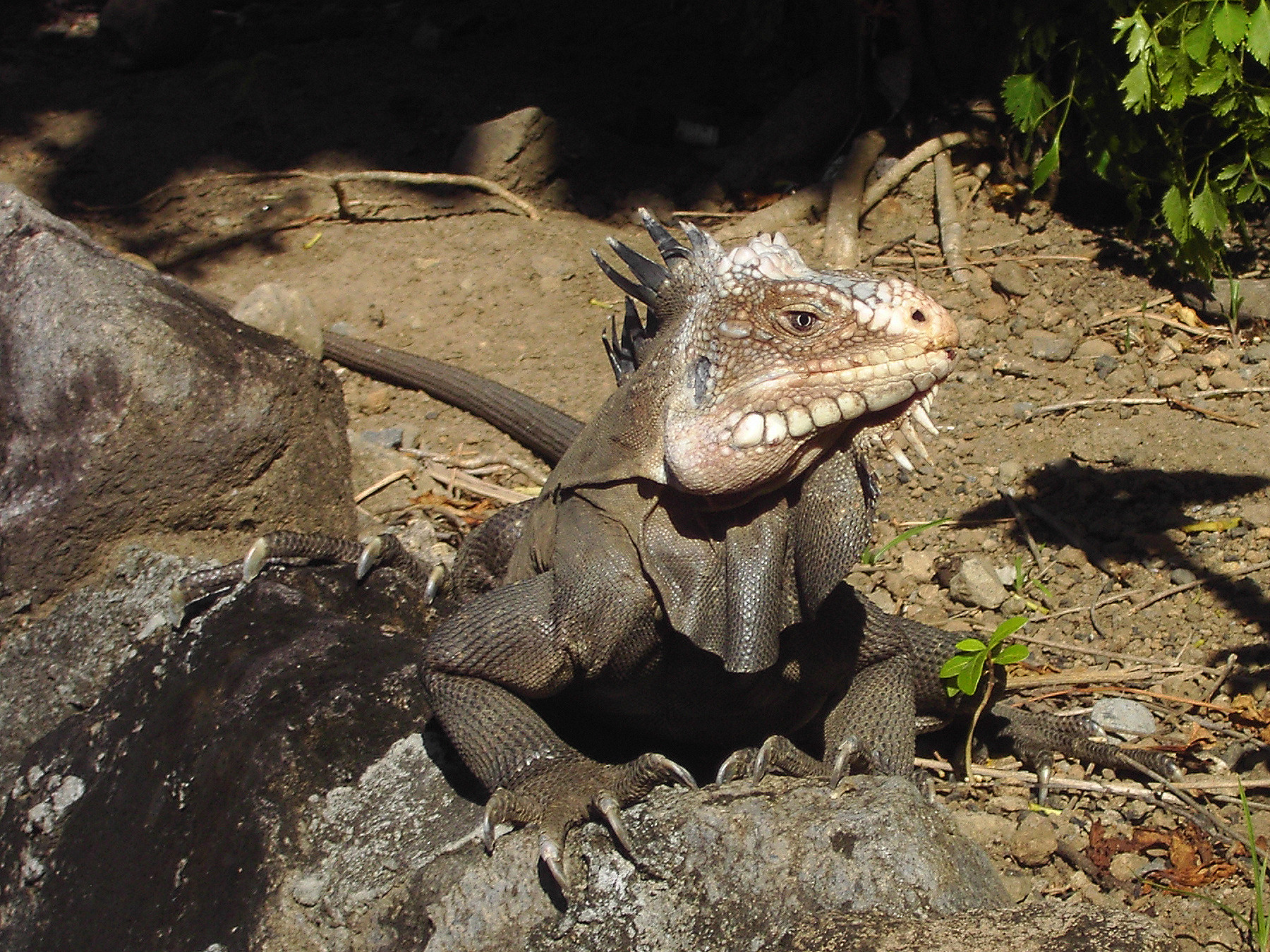- Lesser Antillean Iguana
image_width = 250px
name = Lesser Antillean Iguana
status = VU | status_system = IUCN2.3
regnum =Animal ia
phylum =Chordata
classis = Sauropsida
ordo =Squamata
familia =Iguanidae
genus = "Iguana "
species = "I. delicatissima"
binomial = "Iguana delicatissima"
binomial_authority = Laurenti, 1768The Lesser Antillean Iguana ("Iguana delicatissima") is one of two species of
lizard of the genus "Iguana ". Endemic to the Lesser Antilles it is in severe decline due to habitat destruction, feral predators, hunting, and hybridization with its sister species theGreen iguana .Taxonomy
The generic name "Iguana" is derived from "Iwana", a Spanish form of the
Taino name for the species.citation
last = Coles
first = William
title = Green Iguana
work = U.S.V.I. Animal Fact Sheet #08
publisher = Department of Planning and Natural Resources US Virgin Islands Division of Fish and Wildlife
url = http://www.vifishandwildlife.com/Education/FactSheet/PDF_Docs/08GreenIguana.pdf
date = 2002 ] Its specific name "delicatissima" isLatin for "extraordinary". The species was first officially described by Austriannaturalist Josephus Nicolaus Laurenti in 1768.citation
last = Hollingsworth
first = Bradford D.
title = The Evolution of Iguanas an Overview and a Checklist of Species
work = Iguanas: Biology and Conservation
publisher = University of California Press
pages = 40-41
date = 2004
isbn = 9780520238541 ]Distribution
The Lesser Antillean iguana is found in scrub woodland,
rainforest , andmangrove throughout theLesser Antilles onAnguilla ,St. Martin ,St. Eustatius ,Antigua ,Guadeloupe ,Dominica , andMartinique .Anatomy and morphology
Though belonging to the same genus as the
Green Iguana , the Lesser Antilles Iguana has a more blocky, shortened face than the Green Iguana and lacks the distinctive stripe pattern present along the Green Iguana's tail. The feature that most easily distinguishes these two species is the large, round scale, which the Green iguana has below each ear hole but the Lesser Antillean iguana does not.The Lesser Antillean iguana varies in color between different island populations, but the base color tends to be gray, with green splotching on the underside. They have large pale, ivory colored scales on their heads. The jowls of males are pink and the scales around the eyes are blue. Males also have femoral pores along each inner thigh that exude
pheromones during breeding season. Males are larger than females and are 40cm (16in) long, with an 80cm (32in) tail when full-grown. Females are two-thirds this size.Diet
Lesser Antillean iguanas are primarily
herbivore s, feeding on leaves, flowers, fruit, and growing shoots of upwards of 100 different species of plant.citation
last = Lazell
first = J.D.
title = The lizard genus Iguana in the Lesser Antilles
work = Bulletin of the Museum of Comparative Zoology
location= New York
Volume=145
pages = 1-28
date = 1973 ] This presents a problem forosmoregulation : vegetable matter contains morepotassium and has less nutritional content per gram, so more must be eaten to meet the animal's metabolic needs.citation
last = Hazard
first = Lisa C.
title = Sodium and Pottassium Secretion by Iguana Salt Glands
work = Iguanas: Biology and Conservation
publisher = University of California Press
pages = 84-85
date = 2004
isbn = 9780520238541 ] Like most reptiles, Lesser Antillean iguanas are not capable of creating liquid urine more concentrated than their bodily fluids, like birds they excrete nitrogenous wastes as urate salts through a specially evolved nasalsalt gland . As a result, the iguanas have developed this lateral nasal gland to supplement renal salt secretion by expelling excess potassium and sodium chloride.Conservation
The Lesser Antillean Iguana is a vulnerable species and is found on the
IUCN Red List .] The Lesser Antillean iguana is legally protected from hunting throughout its range, but enforcement of these regulations is extremely difficult and therefore limited. Other threats include habitat loss to agriculture and development and the introduction offeral predators such asdog s, cats, and themongoose .The species greatest threat is from its own genus. The Green iguana has been introduced to the Lesser Antilles as an
invasive species and directly competes with the Lesser Antillean Iguana for food and resources. In addition the Green iguana has been interbreeding with the Lesser Antillean Iguana and this hybridization has been the number one reason for decline on at least three of the islands: Les Iles des Saintes, Basse Terre (Guadeloupe) and St. Barthélemy. Captive Lesser Antillean iguanas are currently kept at theJersey Wildlife Preservation Trust ,Chester Zoo ,Memphis Zoo and theSan Diego Zoo ’s Center for Reproduction of Endangered Species. All individuals originate from the Commonwealth of Dominica. Breeding and keeping the species in captivity is difficult. Mating and egg laying have occurred at each institution but most of the eggs have been infertile, a single individual was successfully hatched at the Jersey Wildlife Preservation Trust in 1997 and in 2000 eight iguanas were hatched. Citation
last = Day
first = Mark
last2 = Breuil
first2 = Michel
last3 = Reichling
first3 = Steve
title = Taxonomic Account Lesser Antillean iguana Iguana delicatissima
journal = IUCN Iguana Specialist Group
year = 2001
url=http://www.iucn-isg.org/actionplan/ch2/lesserantillean.php
date accessed=10/31/2007 ]References
Wikimedia Foundation. 2010.

